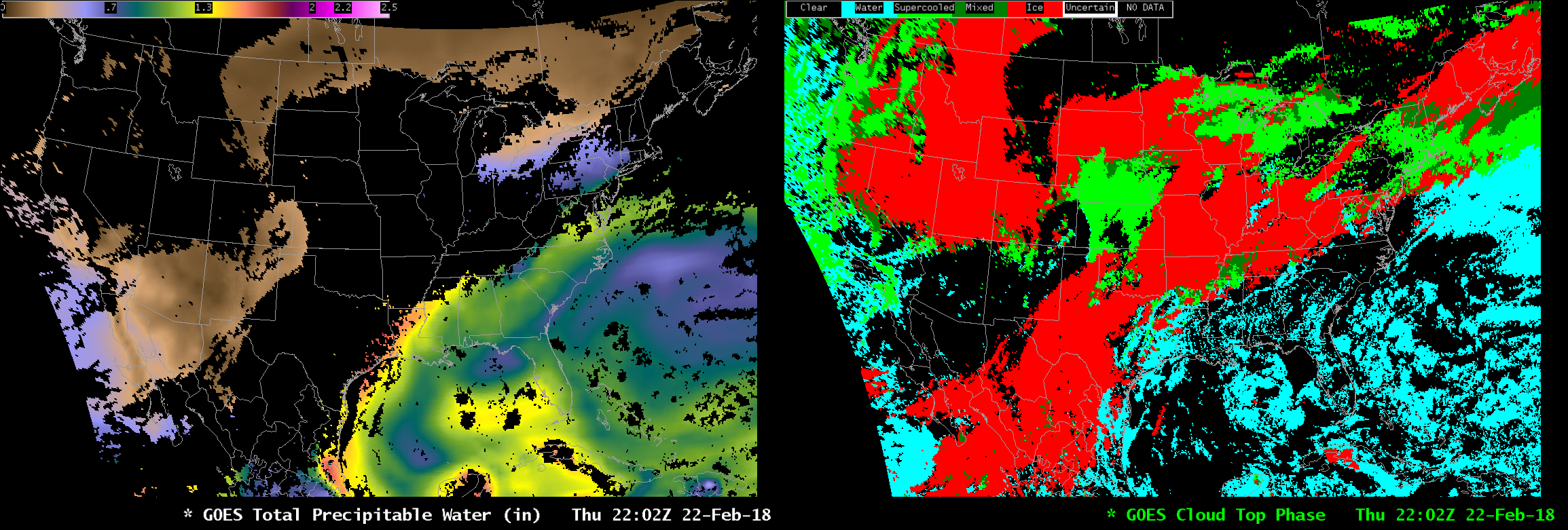
[ Archive ]

 |
CIMSS-NOAA Weekly Report [ Archive ] |
 |
ASPB AND CIMSS WEEKLY HIGHLIGHTS FOR THE WEEK ENDING FEBRUARY 23, 2018
IN THE PRESS:
ITEMS FOR THE ADMINISTRATOR:
ITEMS FOR THE ASSISTANT ADMINISTRATOR:
ITEMS FOR THE OFFICE DIRECTOR, STAR:
GOES-16 Provisional Maturity Review for Cloud Mask and Height: The Provisional Validation Maturity Reviews for the GOES-16 Binary Cloud Mask (BCM) and Advanced Baseline Imager (ABI) Cloud Height Algorithms (ACHA) were held on February 16, 2018. The products from both the BCM and ACHA passed this review. README files, which note their remaining issues, have been submitted to the GOES-R Program Office. For the BCM, several issues remain including some poor performance in the day/night transition, some false clouds in specific regions and some missed clouds at night. For ACHA, the main driver of performance is the reliance of the Derived Motion Winds (DMW) Application, which uses the ACHA cloud-top pressures. While ACHA meets its specification, issues with ACHA cloud-top pressures used by the DMW application remain and will be addressed. The next review for these algorithms will be in late 2018. (A. Heidinger, E/RA2, 608-263-6757, andrew.heidinger@noaa.gov)
GOES-R Soundings and MultipleCloud Products Declared Provisional: The Geostationary Operational Environmental Satellite (GOES) Advanced Baseline Imager (ABI) Level 2+ Provisional Peer Stakeholder-Product Validation Review (PS-PVR) for Cloud Top Phase, Soundings and Cloud Optical and Microphysical Properties was held February 22, 2018. The Cloud Optical Depths (day and night), Cloud Top Phase and Soundings products were deemed to be ready for the provisional stage. Much work was done by the team members to validate the various products against many standards. The Operational Maturity PS-PVRs are scheduled for later in 2018. (M. Pavolonis, E/RA2, 608-263-9597, mpav@ssec.wisc.edu; A. Heidinger, E/RA2, 608-263-6757, andrew.heidinger@noaa.gov; T. Schmit, E/RA2, 608-263-0291, tim.j.schmit@noaa.gov)
 (Click image to enlarge)
(Click image to enlarge)
Figure caption: Example GOES-16 Total Precipitable Water (left) and Cloud Phase (right) images. Both products were declared Provisional this week.
VIIRS Cloud Team Supports NOAA-20 KPP Provisional Review: The Key Performance Parameters (KPP) from NOAA-20 underwent their Provisional Maturity Review this week. As part of this review, several algorithm teams gave short presentations on their assessment of the performance of NOAA-20. Andrew Heidinger showed results from the Visible and Infrared Imaging Radiometer Suite (VIIRS) Cloud Team. These results included a first look at some of the NOAA Enterprise Cloud Products applied to NOAA-20 VIIRS and compared to those from GOES-16. In addition, an analysis of the cloud optical depths indicated that the NOAA-20/VIIRS M5 band does not suffer from the calibration problem that impacted the Suomi National Polar-orbiting Partnership (SNPP) VIIRS sensor. (A. Heidinger, E/RA2, 608-263-6757, andrew.heidinger@noaa.gov)
SOS Movie Featuring GOES-16 Dataset to Debut at the GOES-S launch: As part of the GOES-R Education Proving Ground, the Cooperative Institute for Meteorological Satellite Studies (CIMSS) developed a short movie for NOAA’s Science On a Sphere (SOS) timed to debut at Kennedy Space Center for the Geostationary Operational Environmental Satellite (GOES) – S launch on March 1, 2018. The short movie for SOS, available for preview from https://sos.noaa.gov/datasets/goes-16-tracks-the-big-three/ and directly on Youtube (https://youtu.be/Gv22wi68fYk), recaps highlights of Hurricanes Harvey, Irma, and Maria featuring GOES-16 Advanced Baseline Imagery (ABI) plus a loop of Hurricane Harvey displayed with all new Geostationary Lightning Mapper (GLM) data. Identical ABI and GLM instruments will fly on the GOES-S satellite, which will be renamed GOES-17 in orbit and become GOES West after checkout. (M. Mooney, CIMSS, (608) 265-2123, Clayton Suplinski, SSEC, Tim Schmit, E/RA2, Rick Kohrs, SSEC)
ITEMS FOR THE DIVISION CHIEF, CoRP:
RIVAL Field Campaign Begins at SGP ARM Site Targeting NOAA20: The Radiosonde Inter-comparison & VALidation Field Campaign (RIVAL) field campaign began at the Southern Great Plains (SGP) ARM site with the first dual radiosonde launch coordinated with the NOAA20 overpass on 02/13/2018 1922UTC. This field campaign is a sustained 1-2 year effort, in collaboration with the JPSS Radiosonde Program (Tony Reale, Antonia Gambacorta, & Nick Nalli) and GRUAN, in which weekly dual radiosonde soundings (RS92 & RS41 on same balloon) will be performed at the Eastern North Atlantic (ENA), North Slope Alaska (NSA), and SGP ARM sites targeting NOAA20. RIVAL launches will be used not only to assess RS92/RS41 differences, ensuring the continuity of both the ARM and JPSS radiosonde data sets, but also in the validation of the NOAA-Unique Combined Atmospheric Processing System (NUCAPS) temperature and water vapor retrievals for NOAA20 CrIS/ATMS. (L. Borg, SSEC)
Presentation on GOES-16 to Lockheed Martin: On February 16, 2018 T. Schmit gave a presentation to Lockheed Martin in Littleton, Colorado. The topic of presentation was the many uses of the Advanced Baseline Imager (ABI) on the Geostationary Operational Environmental Satellite (GOES)-16, as shown with on-orbit data. The GOES-T spacecraft is being assembled at this facility. (T. Schmit, E/RA2, 608-263-0291, tim.j.schmit@noaa.gov)
VISITORS:
NEXT WEEK:
LOOKING AHEAD:
| Archived Weeklies Page | Submit a report item |